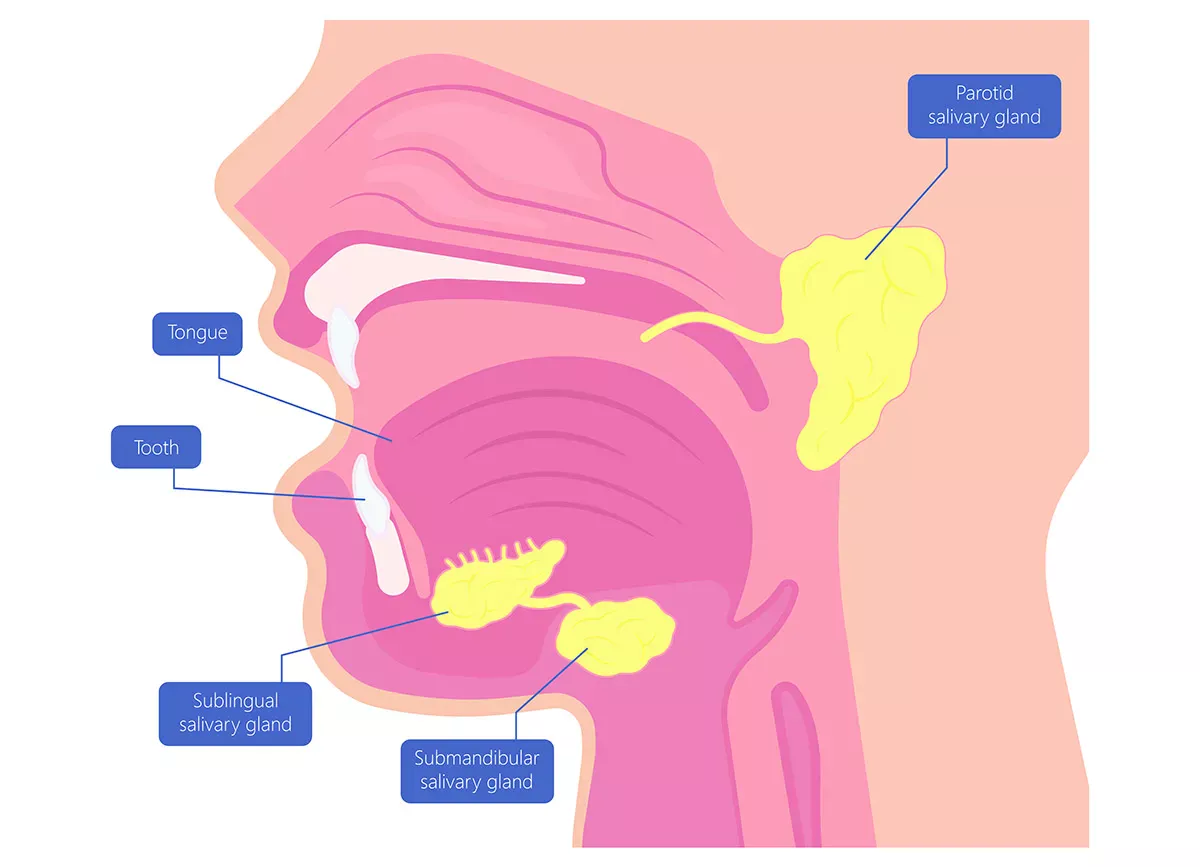Definition: What is salivary gland cancer?
Salivary gland cancer is an extremely rare form of cancer characterised by the development of a malignant tumour within one of the salivary glands. The parotid gland is most commonly affected – in this case, it is known medically as parotid carcinoma. However, there is a diverse range of tumour types in the salivary glands – some tumours grow slowly and metastasise rarely, while others are aggressive and have a higher likelihood of spreading to the neck, lungs or bones.
In Germany, no more than one of every 100,000 people is diagnosed with salivary gland cancer each year. Although this type of cancer can occur at any age, it most commonly affects individuals between the ages of 50 and 70. Salivary gland cancer is very rare among children.
Good to know:
Three quarters of salivary gland tumours are benign. Only one quarter of them are malignant tumours and thus salivary gland cancer. Benign tumours grow more slowly than malignant tumours and have a higher likelihood of being cured. If left untreated, they can, however, potentially transform into malignant tumours.
Prognosis: What are the chances of surviving salivary gland cancer?
The chances of recovery from salivary gland cancer depend greatly on the tumour's location, size and whether it has already metastasised to other parts of the body.
The survival rate is very high, particularly when the tumour is located in the outer region of the parotid gland, has not infiltrated surrounding tissues and exhibits slow growth. The same holds true if the tumour was completely removed during surgery. The prognosis is less favourable if the tumour could not be completely removed. In approximately half of the individuals affected, the tumour recurs – sometimes years later.
Generally speaking, salivary gland cancer is mostly curable and not necessarily fatal. However, in certain cases, it can lead to the formation of distant metastases in vital organs, potentially resulting in a fatal outcome.
Children and young adults typically have a favourable prognosis, with a low likelihood of metastasis forming and a generally slow tumour growth rate in this age group. In the majority of cases, affected children recover fully after treatment.
Symptoms: How does salivary gland cancer manifest?
Salivary gland cancer often goes unnoticed for an extended period of time, as it typically does not cause symptoms in its early stages. The first sign of potential salivary gland cancer is often a visible and painless swelling.
As the disease advances, the following symptoms may occur:
- Pain in the affected area
- Dry mouth/Reduced saliva production
- Difficulty in and pain when swallowing
- Difficulty in speaking
- Tingling sensation/Numbness in the face (even one-sided facial paralysis)
The simultaneous occurrence of facial swelling and facial paralysis is a clear indication of salivary gland cancer. Those affected should seek prompt medical evaluation.
Good to know:
The facial nerve courses directly through the parotid gland. If the facial nerve is irritated or damaged by the tumour, this can result in a condition known as paresthesia: In addition to the sensation of tingling and numbness, individuals experiencing paresthesia may have difficulty in controlling their facial muscles and may no longer be able to frown or smile on one side, for instance.
Where is salivary gland cancer located?
There are three pairs of major salivary glands, each of which can be affected by salivary gland cancer. In general: The larger the salivary gland, the more frequently tumours occur. But the likelihood of the tumour being malignant is notably higher when it involves minor salivary glands.
Parotid gland
The parotid glands are the largest salivary glands and located just in front of the ears. And this is where most salivary gland tumours occur. Roughly 80 percent of them are benign, 20 percent malignant.
Submandibular gland
The submandibular glands are located just under both sides of the lower jaw. About 50 percent of the tumours here are benign.
Sublingual gland
The sublingual glands share the excretory glands with the submandibular glands Around 90 percent of tumours in the salivary glands underneath the tongue are malignant.
Minor salivary glands
Furthermore, there are numerous minor salivary glands that are not visible to the naked eye and are scattered in the oral mucosa throughout the entire mouth and throat region. Salivary gland cancer is very rare in these glands. When tumours develop, the salivary glands on the palate are commonly affected, and the tumour is usually malignant.
Good to know:
Normally, the salivary glands produce between 0.5 and 1.5 litres of saliva daily to keep the oral cavity lubricated and moist, to facilitate swallowing and to protect the teeth against dental decay. Salivary gland cancer reduces saliva production and causes a dry mouth. Unfortunately, even after undergoing treatment, there is sometimes no guarantee of improvement: All treatment measures can potentially result in the side effect of further restricting saliva production and causing a dry mouth. Sugar-free chewing gum and a toothpaste that promotes saliva production are helpful in the fight against a mouth that feels sticky and dry. More tips can be found in our article on dry mouth.
Where does salivary gland cancer spread to?
Not every type of salivary gland cancer forms metastases. However, aggressive forms can spread to nearby lymph nodes or even throughout the entire body, forming distant metastases in the lungs, liver, bones and brain.
Causes: What causes salivary gland cancer?
The cause of salivary gland cancer has not yet been clarified. The disease occurs spontaneously. Doctors believe that the development of a tumour is influenced by a variety of factors. However, it appears evident that salivary gland cancer is not hereditary, as the disease does not usually run in families.
Risk factors
- Certain risk factors can favour the development of salivary gland cancer:
- Smoking
- Regular consumption of alcohol
- Virus infections (including HPV, Epstein-Barr, HIV)
- Previous radiotherapy in the head and neck region
- Previous chemotherapy for the treatment of leukaemia
Diagnosis: Which health care professional should you see about salivary gland cancer?
If salivary gland cancer is suspected, you should go and see your family doctor or an ENT specialist. After discussing the symptoms and your medical history, a physical examination follows, during which the doctor first palpates the areas of the salivary glands, checking for potential swellings and lumps. This is usually followed by an ultrasonic examination.
If the suspicion is confirmed, further imaging techniques – computer tomography (CT) and magnetic resonance imaging (MRI) scans – can be employed to precisely identify the type of tumour and assess the extent and stage of the cancer.
The doctor can also perform a biopsy, taking a tissue sample with a fine needle. However, this step can also be omitted if the imaging techniques clearly show that a tumour is present. Since both benign and malignant tumours of the salivary gland must always be removed. Benign tumours could otherwise develop into malignant tumours. In such cases, a pathologist examines the tissue post-surgery to precisely identify the type of tumour involved.
The actual treatment in a specialist hospital is not the responsibility of a single doctor; rather, a team of experts collaborates in meetings, known as tumour boards, to discuss each case individually and to determine the optimal form of treatment.
The tumour board typically includes representatives from the following disciplines:
- ENT
- Oral and maxillofacial surgery
- Oncology
- Radiotherapy
- Radiology
- Pathology
Treatment of salivary gland cancer
The first step in treating salivary gland cancer involves surgically removing the tumour. Subsequently, if deemed necessary, radiotherapy or chemotherapy may be administered. We will only provide a brief overview of the possible treatment methods below for reference. You can find more information about the individual methods and their side effects in our main article on oral cavity cancer.
Surgery
In the case of salivary gland cancer, surgery is unavoidable, as this is the only method to completely remove the tumour and inhibit the formation of metastases in other parts of the body. In addition to excising the tumour, the surgeon also removes a portion of clinically healthy surrounding tissue as a "safety margin" to deter potential regrowth. If metastases have already formed in the lymph nodes, they must also be surgically removed. This type of surgery is called a "neck dissection".
Operating on the parotid gland involves the risk of injuring the facial nerve. To mitigate this risk, surgeons employ a special facial nerve monitor. However, the function of the facial nerve may still be temporarily impaired for a few months. If the tumour has infiltrated the facial nerve, the affected area must be excised. Fortunately, modern technology enables surgeons to reconstruct the nerve during further surgical procedures. Permanent damage is exceptionally rare.
Radiotherapy
Sometimes it is not possible to completely remove the tumour. In such cases, it may be advisable to undergo radiotherapy in addition to surgery. The doctor irradiates the affected area with highly concentrated X-rays to destroy any remaining cancer cells or to stop their spread.
Chemotherapy
Chemotherapy, i.e. the medication-based treatment against cancer, is typically reserved for advanced stages of salivary gland cancer where metastases have already formed in other organs. Patients receive medication intravenously or in tablet form to destroy cancerous cells throughout the body via the bloodstream.
Good to know:
Cancer patients frequently experience inflammation of the oral mucosa. Neglecting dental hygiene in such cases is, however, a significant mistake, as bacteria can then proliferate unchecked, worsening the inflammation. To ensure that you can still brush your teeth thoroughly, we recommend using a special toothbrush like the CS Surgical from Curaprox, which has been designed specifically for oral care after surgery and safe use near wounds.
Sources:
American Cancer Society: Salivary Gland Cancer.
Centrum für Integrierte Onkologie Aachen Bonn Köln Düsseldorf (CIO): Speicheldrüsenkrebs (Parotiskarzinom).
Deutsche Krebshilfe: Krebs im Mund-Kiefer-Gesichtsbereich (Die blauen Ratgeber).
Inselspital (Universitätsspital Bern): Speicheldrüsentumoren.
Leitlinienprogramm Onkologie (Arbeitsgemeinschaft der Wissenschaftlichen Medizinischen Fachgesellschaften e. V. (AWMF), der Deutschen Krebsgesellschaft e. V. (DKG) und der Stiftung Deutsche Krebshilfe: Patientenleitlinie Mundhöhlenkrebs.
Leitlinienprogramm Onkologie: S3-Leitlinie Diagnostik und Therapie des Mundhöhlenkarzinoms.
Leitner, Astrid: Speicheldrüsenkrebs, at: netdoktor.de
Schiff, Bradley A.: Speicheldrüsenkrebs, at: msdmanuals.com.
Springer Medizin: Speicheldrüsenkrankheiten bei Kindern und Jugendlichen.
Universitätsklinikum Heidelberg: Bösartige Tumoren ausgehend von den Speicheldrüsen.
 Swiss premium oral care
Swiss premium oral care







